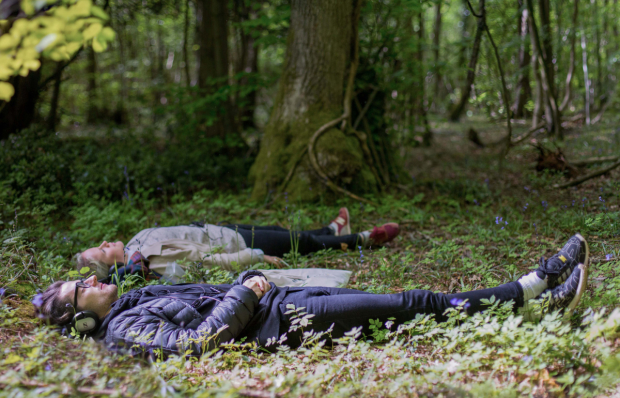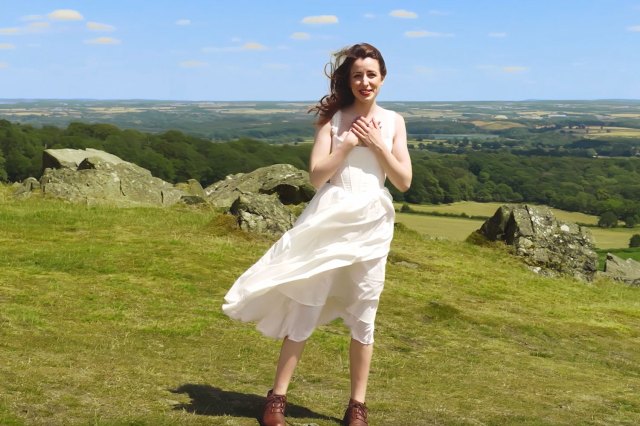There’s an art to a good festival and Bristol's In Between Time gets it right
Matt Trueman on how a good festival is constructed and why the biennial Bristol-based In Between Time works so well

© Paul Blakemore
It’s Friday afternoon, and I’m lying on the floor in the woods. It’s cold, the sort of cold that stings your fingers. I’m told Bristol hasn’t seen snow in ten years, but there are rumours it’s coming this weekend. On my back, I look up at the sky, through bare branches and holly leaves overhead. In my ears, a voice describes the way my body temperature will drop after death, how my muscles will seize and my jaw will lock, how flies will bury into my eyes and lay eggs and bacterial activity will cause my body to bloat, then burst. I’ll decay. I’ll decompose. I’ll fossilise.
Woodland, an audio installation by the UK duo French and Mottershead, is one of those pieces that makes you see the world afresh. It takes you off somewhere, all by yourself, and puts things in perspective. Here you are, it whispers, in the woods; a being, but also a body and, as a body, as an object, just a part of everything else: the earth, a life cycle, all this. It encourages you to envisage death and, like Ontroerend Goed‘s piece World Without Us, to imagine the world as it carries on without you. You’re a part of a whole, of something much bigger.
A good festival builds in spaces for criticism: not written down, but discussed over a drink
Woodland was at In Between Festival this weekend, and I often think the best festivals work on similar lines. Art, at festivals, becomes part of a programme; woven into a wider context, one thing among many. In that setting it grows, and the best festivals enable cross-pollination. It’s one of the very best things about them. Ideas and images circulate, audiences and artists cross paths, places become linked. In close proximity, all these things rub off on each other, and a festival becomes a space for, even an act of, exchange.
Festivals make more of art than it makes of itself. It exists sewn into a support network as audiences arrive already warmed up, alert and alive, their heads buzzing with fresh thoughts still being processed, their senses and synapses firing, their minds open to experience. When they leave, they don’t simply step out, back into the world. They don’t just jump in the car and head home, but stick around – the bar’s open – to drink, talk and swap tips. A good festival builds in spaces for criticism: not written down, but discussed over a drink; not a single broadcast, but a criss-cross of conversations. Response becomes part of the art.
Some festivals encourage audiences to consume as much as possible, barely even digesting it
All this changes the way we consume art. Some festivals fuck that up. The framework encourages audiences to cram as much as they can in – a chance to binge on art, to consume as much as possible, barely even digesting it. Anyone who’s ever done a whirlwind Edinburgh Fringe visit – three days, 30 shows or whatever – will recognise that feeling. Halfway through, you’re stuffed full and sick, hardly concentrating, dozing off. It makes art feel disposable; diminishes it.
A good festival, however, gives you space and time to digest. It turns art into an activity, not an object; places it into a social space. Festivals are meeting places, points of exchange. They’re as much about the gaps and the programme; the in between times, if you like.
There’s an art to a good festival, and In Between Time gets a lot of it right. It takes place every two years, spread out across Bristol and it’s been going since 2001 – four days of live art and performance. It uses the Arnolfini arts centre as a hub; its bar a space for audiences to congregate, its galleries home to durational performances and one-on-one installations. This is a festival that lives up to its name. It gives you the freedom to dictate your own time.
It’s in those gaps that cross-pollination happens, of course. It’s a programme designed for it – one that pairs leading live artists and makers like Forced Entertainment and Lone Twin with a whole bill of emerging artists in its New Bloods strand. Having gone down to see Forced Entertainment’s Real Magic, I met Hannah Sullivan’s work for the first time. With Force and Noise is a carefully-constructed and deeply focused piece about anger; one that squeezes timidity until it bursts into rage; that shakes itself into action and sets off alarm bells.
The festival becomes an open invitation to new audiences
In terms of introductions, In Between Time goes further. 600 Highwaymen’s The Record, involves 45 Bristolians from all walks of life, all sharing a stage and standing together. It’s a beautiful, spirited, honest performance: testimony to a city and the people that make it, but I’ll bet some of them, being part of the festival, went and saw stuff they wouldn’t otherwise have done. With that, the festival becomes an introduction to the art form as a whole – an open invitation to new audiences.
The strand of work for kids – not something you see at every festival – does something similar. Lone Twin’s Beastie stalks through the city: an odd Yeti-ish monster created out of workshops with kids then unleashed. Sibylle Peters’ Playing Up, presented by Arts Admin, hands over a whole gallery to the creative process of child’s play. Given live art can tend towards the adult – in its complexity, but also in its bodies and its darkness – inviting kids in changes things. It lightens and enlivens, opens an art form that can sit in a silo. Watching Real Magic, I saw a few kids and adolescents in the audience, laughing along – as well they might, given its silly streak. It’s a reminder that different audiences engage in different ways, and that experimental, edgy art doesn’t belong in the woods.













